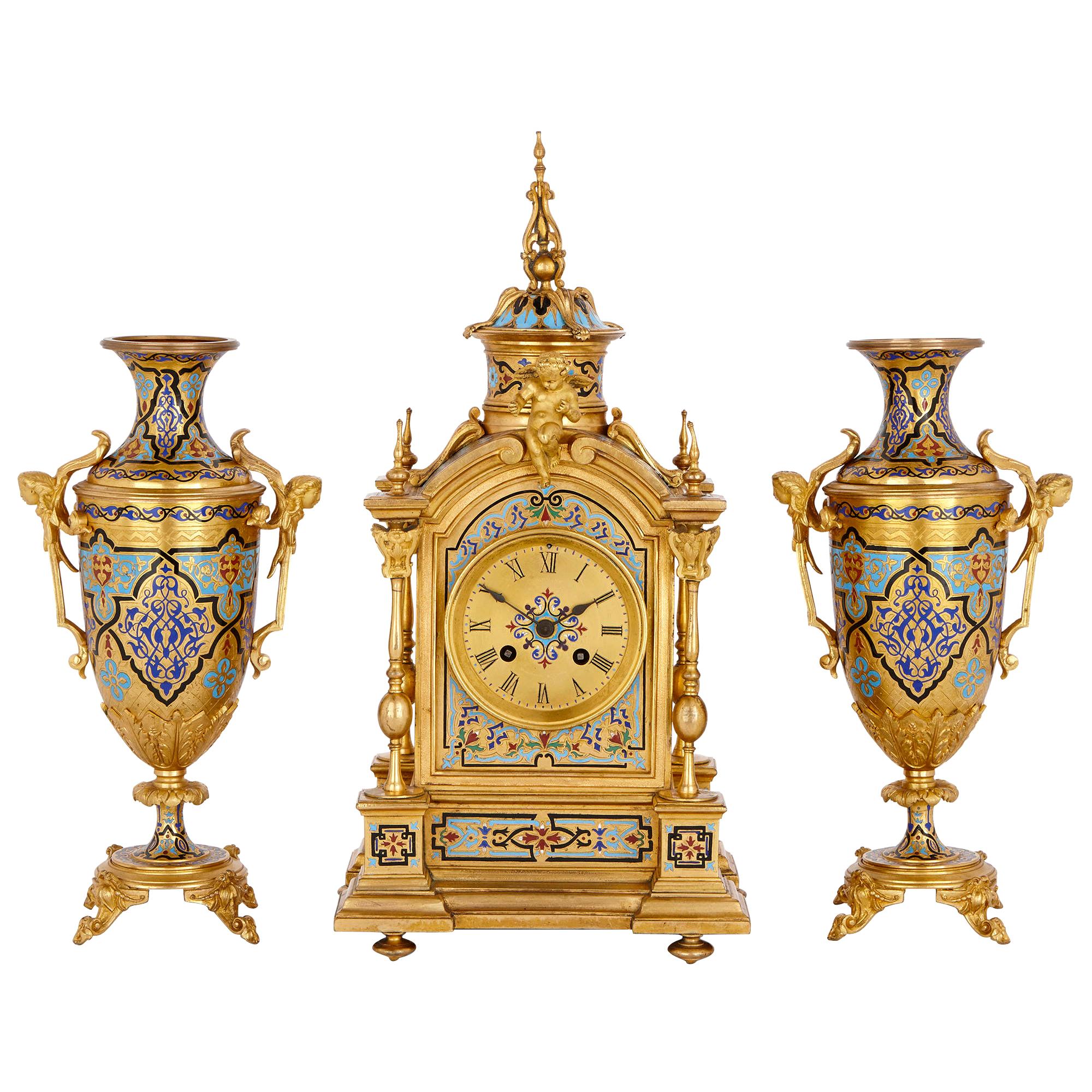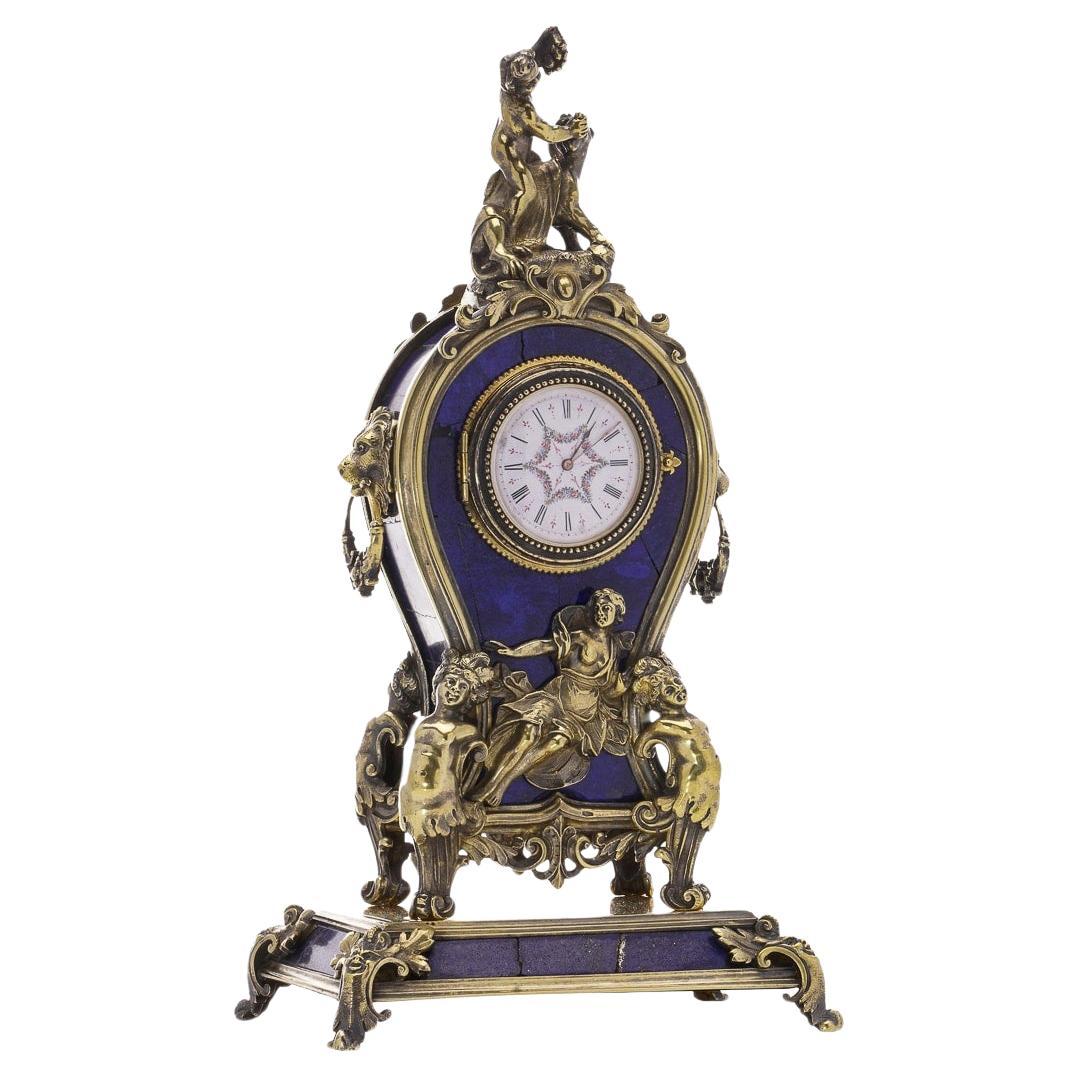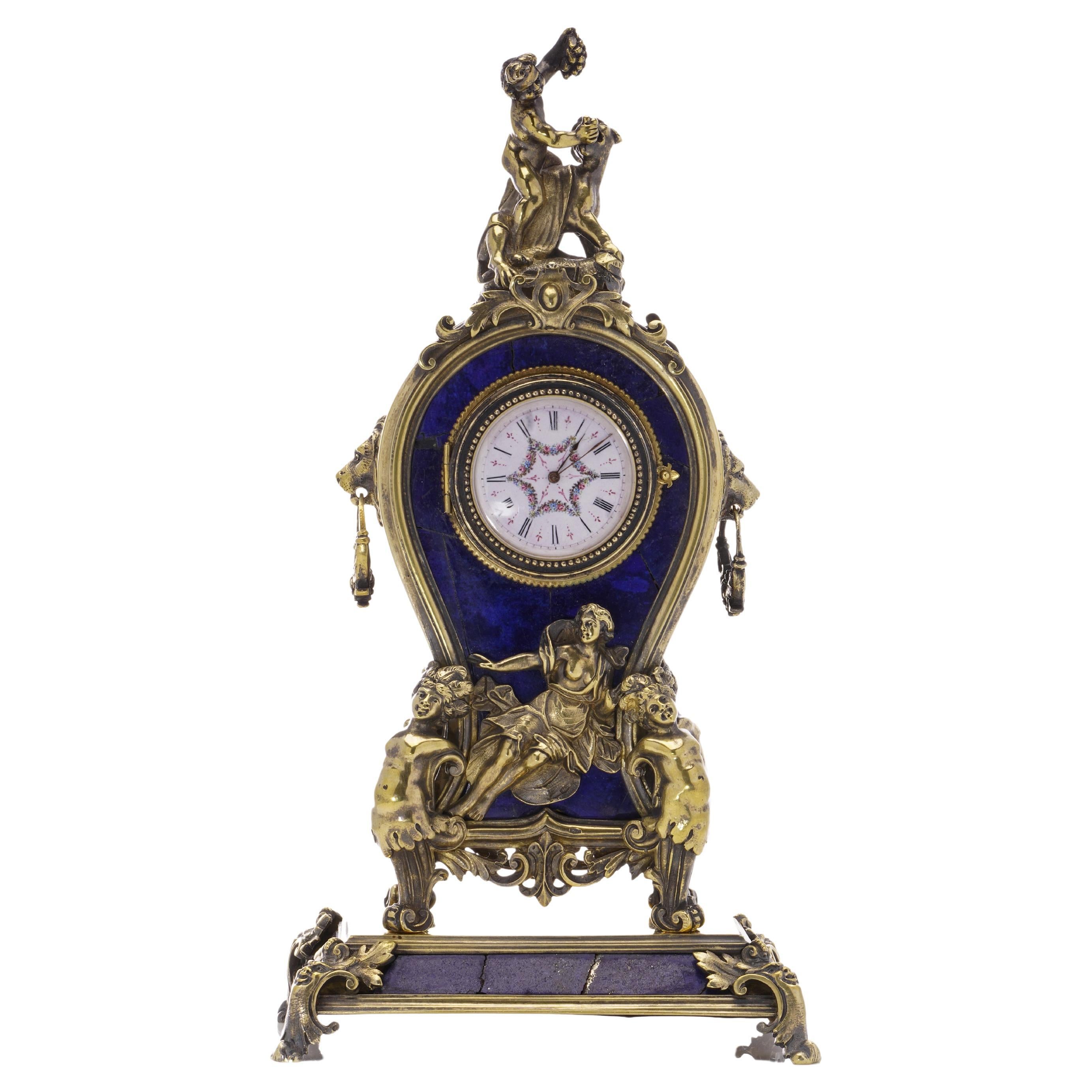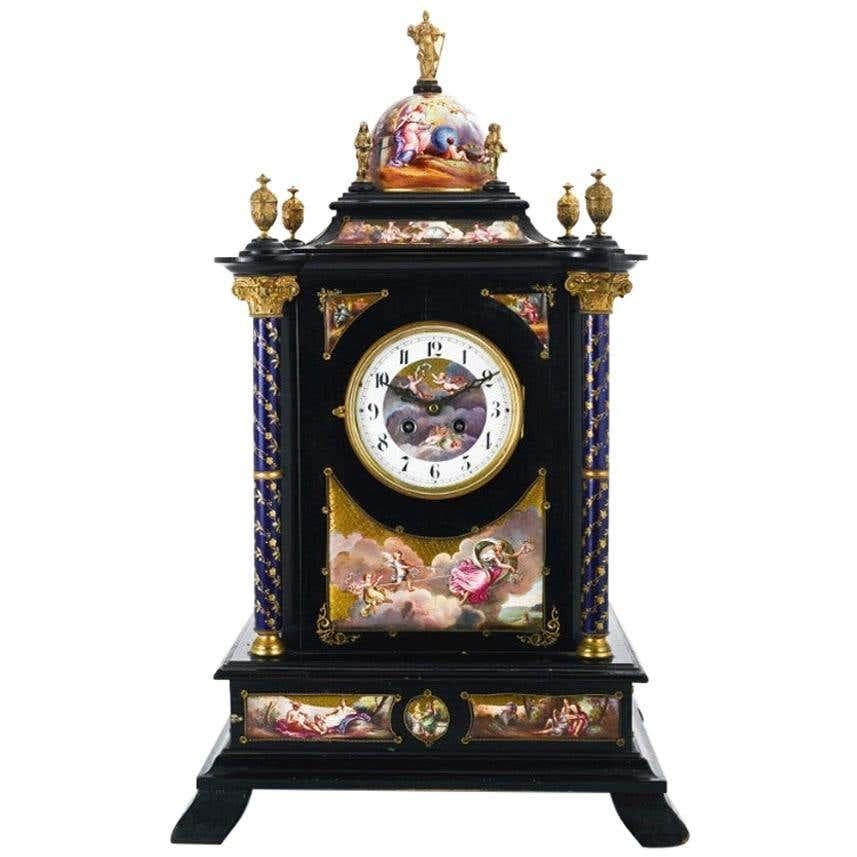Items Similar to Impressive Antique Austrian Champlevé Enamel, Silver-Gilt and Lapis Lazuli Clock
Want more images or videos?
Request additional images or videos from the seller
1 of 21
Impressive Antique Austrian Champlevé Enamel, Silver-Gilt and Lapis Lazuli Clock
About the Item
Impressive antique Austrian champlevé enamel, silver-gilt and lapis lazuli clock set
Austrian, Late 19th century
Clock: Height 91cm, width 37cm, depth 37cm
Candelabra: Height 64cm, width 24cm, depth 24cm
Clock case: Height 97cm, width 44cm, depth 41cm
Candelabra case: 67cm, width 27cm, depth 27cm
Crafted in Austria in the late 19th century, this magnificent three-piece clock set was most likely gifted to the Imperial Russian family by the Austro-Hungarian Royal family. Its design is inspired by various cultures and styles, whilst its high quality celebrates some of the best craftsmen of the late 19th century.
Of a tiered pagoda shape, the clock is surmounted by an eagle, its wings spread wide landing atop a vibrant lapis lazuli ball. The eagle is most likely a reference to Turul, a mythological animal which is a symbol of Hungary. This bird of prey is also a popular feature within Turkish traditions.
Within a canopy, supported on four sturdy lapis lazuli pillars two prominent silver-gilt bells are hanging. These are carved with various motifs such as acanthus leaf design and connect to the clock mechanism below. The bells ring informing its users of the time.
All four sides of the piece are inset with a clock, an unusual feature on an object of this type and a testament to its highest quality. The inclusion of clocks on all sides signifies that the antique is aimed to be a centrepiece, admired from all sides. The dial is decorated using the champlevé enamelling technique, whereby ‘parcels’ are carved into the silver gilt and into which enamel is poured. The 12 numbers are coloured in black with a gold outline and are surrounded by a white circular background making them stand out and easy to read. The hour clock dial is cast in the form of a sun, while the minute hand is represented as the moon. The two motifs symbolise one’s bright and gloomy sides of existence.
The four corners around the clocks are mounted with three-dimensional female figures dressed in traditional garments from around the world. For example, one figure is dressed in typical Turkish clothing while another is influenced by Classical Greece. The large panels surrounding the clock and the figures are carved from lapis lazuli, a semi-precious stone coloured in vibrant and deep blue tones.
The third and largest panel of the pagoda-shaped clock is occupied by four larger panels filled with champlevé enamel illustrations. Most likely the panels depict spring, summer, autumn and winter embodied by Horae, the Greek goddess of the four seasons. The illustrations are surrounded by various silver-gilt and enamel mounts and the four corners are made to look like Corinthian columns. The numerous acanthus leaf motifs and other classical Greek and Rome references, demonstrate the artists’ desire to pay homage to these cultures’ rich heritage.
The base of the clock includes further vivid lapis lazuli panels framed by cream and gold borders. Foliate motifs are executed with female masks added in the middle. The clock stands on four acanthus leaf-shaped feet.
The two flanking candelabra are of a very similar design to the clock creating a cohesive narrative. A single column emerges from the stepped base, too of a pagoda-form from which four angular branches grow. The central column as well as the four branches terminate in candle holders and drip pans, each expertly decorated using the champlevé enamelling technique. All larger panels are mounted with the semi-precious blue stone. The bottom tier of the candelabra is decorated with various illustrations of, for example, a globe and a telescope. This design is in keeping with the design of the clock. Four lapis lazuli vases filled with silver gilt and enamel flowers are mounted on the four corners of the candelabra. These details as well as many others, are what make this clock set an extraordinary museum-worthy antique. Each level is divided by a very ornate roof, its shape reminiscent of ones traditionally found on Chinese pagodas.
Throughout all three pieces, tones of blue, orange, red, green, and yellow predominate creating an exciting, eye-catching and attention-grabbing final result.
This three-piece Austrian clock set comes with original leather, velvet lined cases, each one with metal handles for easier transport.
The design and execution are done in the style of a renowned Austrian maker, Karl Rössler, who specialised in the production of enamel, silver, and lapis lazuli decorative objects. Hermann Böhm, another Austrian artist of the late 19th century too produced objects of this type.
The rich and elegant conglomeration of cultures and styles, meticulous craftsmanship and attention to detail as well as the royal provenance make this a very impressive, desirable, and museum-worthy addition to one’s collection.
- Dimensions:Height: 14.57 in (37 cm)Width: 14.57 in (37 cm)Depth: 35.83 in (91 cm)
- Sold As:Set of 3
- Materials and Techniques:
- Place of Origin:
- Period:
- Date of Manufacture:Late 19th century
- Condition:Wear consistent with age and use.
- Seller Location:London, GB
- Reference Number:
About the Seller
5.0
Recognized Seller
These prestigious sellers are industry leaders and represent the highest echelon for item quality and design.
Established in 1975
1stDibs seller since 2012
362 sales on 1stDibs
Typical response time: 5 hours
Associations
The British Antique Dealers' AssociationInternational Confederation of Art and Antique Dealers' Associations
- ShippingRetrieving quote...Ships From: London, United Kingdom
- Return PolicyA return for this item may be initiated within 14 days of delivery.
More From This SellerView All
- Antique Gilt Bronze and Champlevé Enamel Clock SetLocated in London, GBThis beautiful clock set, which comprises of a mantel clock and a pair of vases, was designed in France in circa 1870 in a wonderful Renaissance Revival style. The set has been craft...Category
Antique Late 19th Century French Renaissance Revival Mantel Clocks
MaterialsOrmolu, Bronze, Enamel
- Neoclassical Style Gilt Bronze, Enamel and Lapis Lazuli Mantel ClockBy Maison Marnyhac 1Located in London, GBThis Grecian style mantel clock was crafted at the end of the 19th century and retailed by the acclaimed Maison Marnyhac, which was based on the Rue de la Paix in Paris. Founded ...Category
Antique Late 19th Century French Classical Greek Mantel Clocks
MaterialsLapis Lazuli, Bronze, Enamel
- Antique French Gilt Bronze and Lapis Lazuli Mantel Clock after FalconetBy Étienne Maurice FalconetLocated in London, GBFrench sculptor Etienne-Maurice Falconet (1716-1791) is the inspiration for this beautiful, sumptuous mantel clock. His clock, crafted in the late 18th Century and now on display at the Louvre Museum, caused such a stir when it was exhibited over 100 years later, at the Great Exhibition in Paris in 1900 that one reviewer claimed that it "attracted so much admiration from the crowds gathered around that the pressure was sufficient at times to endanger its safety." As well as this famed 'Three Graces...Category
Antique 19th Century French Louis XVI Mantel Clocks
MaterialsLapis Lazuli, Ormolu, Bronze
- Austrian Enamel and Silver-Gilt Clock by Ludwig PolitzerBy Ludwig PolitzerLocated in London, GBThis magnificent silver-gilt and enamel lamp-form clock was produced in Vienna in circa 1870. The clock sits on a lozenge-shaped base, which is enamelled with panels depicting reclin...Category
Antique Mid-19th Century Austrian Belle Époque Mantel Clocks
MaterialsSilver, Enamel
- Oriental Style Gilt Bronze and Champlevé Enamel Clock SetLocated in London, GBThis clock set was designed in France in the late 19th century in a fanciful ‘Oriental’ style. The set is comprised of a mantel clock and a pair of candelabra, all of which have been...Category
Antique Late 19th Century French Chinoiserie Mantel Clocks
MaterialsOrmolu, Bronze, Enamel
- Onyx, Marble, Gilt Bronze and Champlevé Enamel Pedestal ClockLocated in London, GBThis colorful pedestal clock has been crafted from fine red marble and green onyx, and beautifully decorated with gilt bronze (ormolu) and champlevé enamel. While a popular crafts material in ancient times, onyx was largely forgotten about until its rediscovery in the mid-19th century in Algeria by a French marble-worker called Delmonte. Onyx became highly fashionable in France following this discovery, and it was used to create a variety of decorative art objects. The clock features a green onyx cube-shaped case, which is surmounted by a slightly projecting red marble top. This top is fringed with champlevé enamel drapery-like motifs, with gilt bronze drop-finials. The case is mounted on its front with a circular dial, which features a central floral champlevé enamel motif, encircled by black Arabic Numerals. This dial is set within a gilt bronze egg-and-dart and champlevé enamel bezel. The sides of the case are mounted with circular gilt bronze barometers...Category
Antique Late 19th Century French Neoclassical Grandfather Clocks and Lon...
MaterialsOnyx, Marble, Bronze, Enamel, Ormolu
You May Also Like
- Antique 19th Century Austrian Silver & Lapis Lazuli Clock, Vienna c.1890Located in Royal Tunbridge Wells, KentAntique late-19th Century Austrian exceptional solid silver gilt & lapis lazuli miniature clock, At the top, a cherub feeds grapes to a panther, while a pair of lion masks adorn the ...Category
Antique 1890s Austrian Table Clocks and Desk Clocks
MaterialsLapis Lazuli, Silver
- Antique Austro-Hungarian 800 Silver and Lapis Lazuli ClockLocated in Braintree, GBStep into the enchanting world of time with our Antique Austro-Hungarian 800 Silver and Lapis Lazuli Clock. An opulent masterpiece that transcends the ordinary, weaving together sil...Category
Antique Late 19th Century Austrian Table Clocks and Desk Clocks
MaterialsLapis Lazuli, Silver
- French Champleve Gilt Bronze and Enamel Clock GarnitureLocated in New York, NYFrench Champleve Gilt Bronze and Enamel Clock Garniture three piece set . Includes clock and a pair of candlesticks Paris - France, c. 1880s candlesticks - h 9.75 in; diam 4.5 in cl...Category
Antique 19th Century French More Clocks
MaterialsEnamel
- Austrian Silver Gilt, Wood and Enamel Clock Cabinet TableLocated in New York, NYAustrian silver-gilt, wood & enamel clock cabinet table Classical figures painted on a gilt diaper bottom. An enamel clock face, matching the corners. Columns made of Corinthian w...Category
Antique Early 1900s Austrian Apothecary Cabinets
MaterialsSilver, Enamel
- Fine Gilt-Bronze and Champlevé Enamel Clock, circa 1880Located in Brighton, West SussexA fine gilt bronze and champlevé enamel clock. French, circa 1880. The movement with impressed stamp to the backplate 'Vincenti et Cie 'Médaille D'Argent 1855', 'PARIS'. Thi...Category
Antique Late 19th Century French Mantel Clocks
MaterialsBronze, Enamel
- Antique Viennese Enamel and Silver Gilt Clock Austria circa 1870 Bird OstrichLocated in London, GBA pretty Antique Silver Gilt and Viennese Enamel Clock. This oval Clock rests on the back of an ostrich, which in turn stands on a domed base. Th...Category
Antique 19th Century Austrian Table Clocks and Desk Clocks
MaterialsSilver, Enamel
Recently Viewed
View AllMore Ways To Browse
Jlc Furniture
Bakelite Clock
Austrian Zappler Clock
Cartier Must Clock
Gucci Alarm Clock
Junghans Meister
Kundo World Clock
Luxor Clock
Luxor Swiss Desk Clock
Patek Philippe Complicated Desk Clock
Vintage Bayard Alarm Clock
Vintage Westclox Clocks
Vintage Westclox
Antique Coo Coo Clock
Antique Lighthouse Clock
Atmo Globe
French Lighthouse Clock
Heinrich M�ller On Sale





